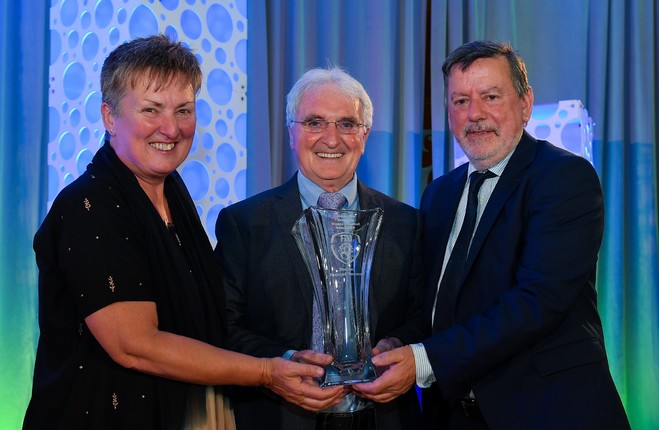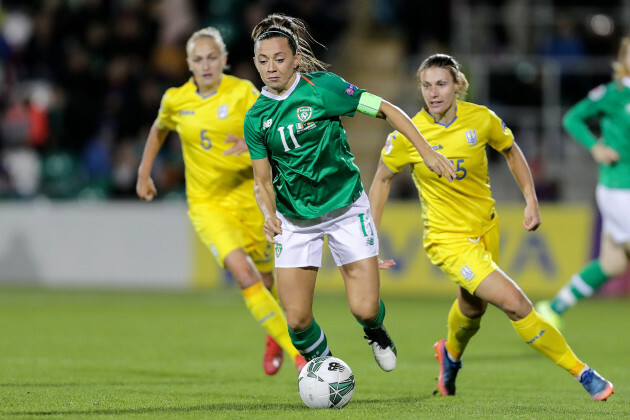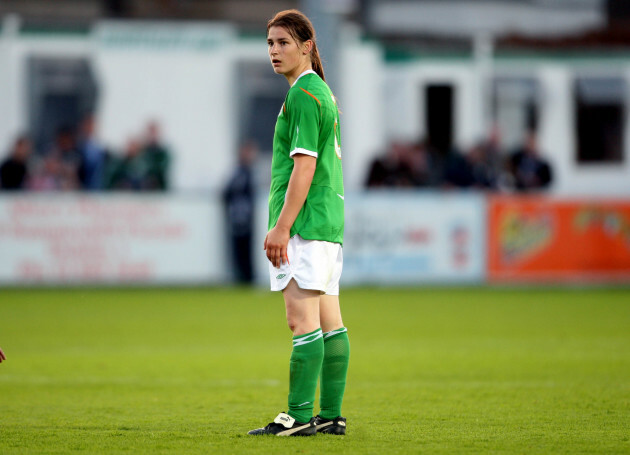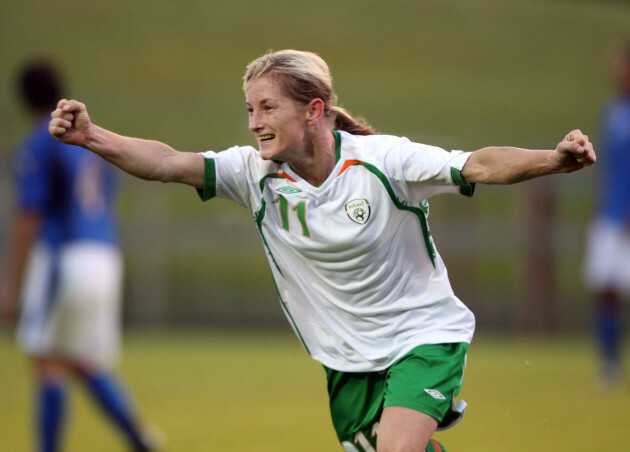LAST MONTH, THE Irish Women’s national team beat Ukraine 3-2 in their Euro 2021 qualifier at Tallaght Stadium in front of a record crowd of 5,328.
While problems continue to exist, most notably the well-documented issues with the national league, it was more evidence that women’s football in Ireland is, to some degree at least, moving in the right direction and attracting greater levels of interest.
Games are being screened live on national TV more frequently, and media coverage in general has increased, with campaigns such as the 20×20 initiate contributing to the improvements in this regard.
The athletes involved deserve plenty of credit for their influence in driving these changes, but the role of community organisers around the country who have helped grow the game at grassroots level should not be overlooked.
One such figure is Brother Bernard Twomey. A founder member of St Catherine’s Ladies Football Club, he helped guide the team to three Women’s FAI Cup finals, triumphing in 2011.
A number of highly talented Irish footballers have come through the ranks at St Catherine’s, including Noelle Murray, Olivia O’Toole, Caroline Thorpe and Michelle Walsh. Katie Taylor and Hannah Tyrrell, better known for their feats in boxing and rugby respectively, also featured for the club.
And from his arrival at the St Catherine’s Parish on Meath Street in 1981, just over 38 years ago, to the present day, Twomey has devoted much of his time there to giving children the opportunity to play football at all levels.
“We had a girls’ club, which was started here about 1976 by Brother Patrick Lennon, who was an Augustinian as well,” Twomey tells The42.
“He was born and reared in Dublin and he had a great idea of what was happening in Dublin. As a young lad himself, he was very involved in youth work.
When he came here, there were many clubs for boys, but there was absolutely nothing for girls. He set up a girls’ club — it was the only all-girls club.
“In the ’40s, ’50s, ’60s, ’70s and ’80s, youth clubs were probably the biggest thing in Dublin.
“It was through youth clubs that the Catholic Youth Council ran clubs all over Dublin and Leinster. Before the Dublin District Schoolboys League started, the CYC were running competitions for boys and girls.
“They were the only organisation that was running any kind of sports for young people. So [Brother Patrick] saw the need for girls. There were lots of girls in the area and they just had nothing to do after school. So he set up this youth club and it involved everything. It was running five nights a week. From seven year olds up to 18. He got in leavers. They had drama, dancing, question time, table tennis and football just happened to be one of the activities, before there was competition for girls as well at the CYC.
“There were four competitions every year. It was all five-a-side indoor that was played from October until March. There were 12s, 14s, 16s and 18s. That’s kind of what started the football in the area. They played football through the youth club.”
While it was a less progressive time in many respects, Twomey plays down the notion that girls or women playing soccer was particularly frowned upon by members of the community even in that era.
“The beauty of it was, in the CYC, they always had equal opportunities for boys and girls.
“We’d go out and play table tennis against other girls. So there was always competition and it was never an issue at all, which was brilliant.”
He continues: “The whole thing was a bit of a surprise to me.
“I knew Dublin because I lived there for a few years before I went to Dungarvan and came back. But youth clubs I would have known very little about what they did.
“The amount of work that went on and the dedication of the people, I was amazed. The work the parents [dedicated to it].
“The club would start in the evening time. It could start at six and be going on until 10.”
Some of the memories from this period remain etched in Twomey’s mind, but changes in Irish life led to a gradual decline in the popularity of these youth clubs.
“The need is different now. It died away many years ago. Things are more prosperous. People go abroad on holidays in the summer time.
One of the big things in the club at the time was we had an annual holiday to Wales. The kids knew every year that there’d be this trip to Wales with about 60 or 70 girls. They would start saving in October. We had a little piggy bank thing and and they fundraised. That was the big thing, to get on the trip to Wales. It was just like going to Heaven.
“Butlins was where some parents went — to go to Butlins was a huge thing. Parents brought their kids and went to the chalets for a week or so. But it was a fantastic experience for the girls to go away and let them meet so many other people from England, Scotland and Wales. It was great.
“We were good at drama and entertaining, and we used to go in to all the shows over there as well. We used to win a lot of stuff, because the girls from the area were very talented.
“You could nearly see [its dying out] coming with prosperity — there are so many other things happening in their lives, there’s something more interesting, the need wasn’t there.
“There was Irish dancing, hip-hop dancing, disco dancing. We used to train in the club in the competitions for the disco. It was competitive enough, there was always interest.
“[The clubs were] great for meeting people. Young people starting off would be shy and timid. You had different age groups as well. They weren’t all thrown in together. You had nine to seven year olds and 10 to 14. Some of the senior girls would be coming back and going to secondary school. They’d come in and help the [younger] kids. It was a lovely idea in its time.”
Undoubtedly the most famous athlete to come through St Catherine’s was boxing superstar Katie Taylor. The Bray native was good enough at soccer to be capped by Ireland, but ultimately chose to go down a different route.
“Katie played for us for a season or two. At that time, she was big into the boxing. She was a high-performance athlete, she couldn’t take the risk if anything happened, it was always a concern.
“She loved playing and she wanted to play, but it was just too much if anything happened to her.
“There were an awful lot of girls in those leagues that could have been anything. They were equally as good as [ex-Ireland international] Susan Byrne and Katie, some fabulous players playing in the Dublin leagues.
Inner-city kids wouldn’t really have the same opportunities. A lot of kids from outside the area would get huge family support if they were picked to play for Ireland. You’d have huge backing from all your family and it was a great thing to do. A lot of my girls would just go off and play. It’s great if you have your family supporting you.
“She had great family support, Katie. So had Sue — her dad was a big supporter.”
Of all the players Twomey witnessed, one in particular who stood out was Olivia O’Toole, Ireland’s record goalscorer and a player regarded by many as the greatest footballer the country has produced.
“I’ve seen them all, but there’ll never be another Olivia,” he says. “She was just an unbelievable footballer.
“They do extraordinary things and they just take it for granted that everybody can be like this. I think that’s the most beautiful thing about a young player — they don’t see themselves as standing out. If that’s coached out of a player, that would be very bad. Who could tell George Best what to do? It’s just magic. And Olivia was like that, she could just glide past three or four players.
“She’d put the ball in the corner of the net and just turn around, and walk away, as if everybody should be doing it.
“They had a club in Sheriff Street. Olivia was down there. We used to play them, we had brilliant games, and we used to be killing each other. It was always down to us in the final. One day, I suggested to one of their managers to join up and form a team between the two clubs in the league — we started and it was just magic. About three years after, we won two U16 All-Irelands back to back. We had no pitch, nothing, just played up in Walkinstown. But there were some great players.”
Oddly enough for someone who has spent much of his life devoted to soccer, Twomey actually grew up as a hurling fanatic.
“Where I come from, they would have never heard of a football [at the time],” he explains. “It would be totally hurling. I played a huge amount of hurling as a young fella. It would have been huge in my area. East Cork I would have played for.”
Of his formative experiences observing soccer, he adds: “At the youth club, I started going round to the five-a-sides and just the skill level was astonishing. And there was no coaching. That saddens me a little bit — a lot of the players today, the natural skills they have is being coached out of them and they are set into a discipline. All the coaches are teaching the same things, so there’s no room for variety.
“Anyone can read a book and say I’ll coach an individual team, but they don’t have love for individual skills at all.
“I said ‘it’s a bit like hurling,’ because hurling is the greatest game. Soccer is very skilful as well. You need great skill to play it — speed, pace, thinking.
When I was young, I’d have loved to have been a professional hurler. I got so much enjoyment out of it. When I saw those girls do those things, I put myself in their place and said: ‘Wouldn’t it be just lovely if they got an opportunity [at a higher level]?’
“One of the first games I saw, a body that contributed a lot and I never hear mentioned now is the Community Games. They always had girls’ sports. It was just lovely the way they went out and played.
“I saw a Leinster final. I went to see it especially to know what 11-a-side girls game is like. And it was a team from Lakeside in Wicklow. I went to see that final and it was just magnificent. I said to myself, if we can go along and start playing and training, we can reach this and we went on and won two Community Games.”
In terms of the tactics and more technical elements of the modern game, Twomey admits: “It’s beyond me.”
He considers himself more as someone who facilitated matches rather than an out-and-out coach.
“I’d have been very involved in the management. We had a huge asset in the area — a parish mini-bus. Nobody had transport then. So to have a mini-bus and be able to pick up girls in their houses, the parents knew where they were, that was the big thing really.
“You’d have to go to Kells to play a match at seven o’clock in the evening. If you didn’t have transport, you couldn’t go. So I was able to drive the mini-bus.
“It was a big advantage. You could organise a friendly match, because you knew you had the mini bus to pick up the girls. A lot of clubs didn’t have that. We would have never managed without it. We would have been just paying for petrol or whatever. There was hardly a car when I came here first.”
Twomey stepped away from an active involvement in organising football matches roughly two years ago.
“In the inner city, kids weren’t interested in playing. You’d have to go outside the inner city to get players.
“A lot of the players I had in the beginning, a lot of parents left here in the late ’80s and ’90s and moved outside to Ballyfermot, Cherry Orchard, Clondalkin. I still followed those players, because I knew their parents, and there was nothing in Clondalkin at the time. They were just houses, there weren’t even shops. I used to pick them up to play.
“It was brilliant, they all developed their own clubs out there and the players were out there. In the inner city now, there wouldn’t be many kids playing.
Nearly every pub in the street had their own team. But the commitment is a big thing [now]. People want to play, but they don’t want to train or commit themselves. You could be going with eight or nine players.
“Social football costs as much money to run as competitive football. It’s a big sacrifice.”
Earlier this year, Twomey was recognised by the FAI with the Jeremy Dee Services to Women’s Football Award. It was a fitting honour made all the more poignant by the fact that the accolade is named after his late friend.
As we sit drinking coffee in the parish, Twomey gets out of his chair to proudly show the award to The42.
“It was a shock and I thought it might be fake news in the beginning. I couldn’t believe it. I was just a cog in a very big wheel. The players that played, they made the club. It wasn’t me.
“The person it’s named after, Jeremy, was a very good friend of mine. Jeremy was probably the person that did most to promote and try to get the National League started. So much so that he managed Castlebar Celtic to go into the National League so they’d get the proper numbers. Unfortunately, he was going to a match, picking up a player and his car skidded and he was killed.
“About two weeks before that, I was with him at a meeting in Abbotstown. It was such a shock to football. I felt privileged to get that award because of the person Jeremy was.
“He was only in his 40s. It was only in the second year of the National League. It was just so sad.”
While Twomey is no longer as directly involved in football as he once was, he still regularly attends games, both at local and Women’s National League level.
He remembers being struck by one youngster in particular a couple of years back: “I saw Rianna Jarrett when she was 12 and she was doing the same kind of things [as she is for Ireland and Wexford Youths now]. She’s done three cruciates. But I haven’t seen her so fit looking since she was underage. She’s playing absolutely brilliant. She’s gone through awful hard times with injuries.”
He continues: “I know a lot of girls that played for me, their kids are playing and I still meet them out at matches.
“It’s massive to see girls that played for me 20-25 years ago going to a match. They’d be standing on the sideline and say: ‘Howya Bernard?’ She’d say who she was and ‘that’s my daughter’. It’s magic to see.”
Twomey, meanwhile, is dismissive when asked about his legacy in the game.
I wouldn’t have any legacy. Football did more for me than I ever did for football. The people I met, honest to goodness. Hurling would have been my game. The people that looked after us and the work they did, so we could play, I always recognised that. I said if I ever get a chance to do that for other people… It was just a privilege.
“I’m interested in all sports, all the unsung heroes. You’ll see people winning an All-Ireland and it’s all grand for a couple of weeks with the headlines, but what went into that and the people involved, they should always be recognised and very often, they should be getting the awards.
“I can go anywhere today around the country and I’d meet people for years that would be killing each other on the sidelines. You could have the greatest conversation and the laughs we’d have.
“Long ago, the people from this area [Meath Street] wouldn’t go to Sheriff Street, they just wouldn’t go. And the people from Sheriff Street wouldn’t come up here.
“So my little mission statement in the beginning was integration through sport. It was a completely different integration, you’re just talking about two parts of the city. Now, with integration, we’d be talking about all the different nationalities.
“But actually, they weren’t even meeting, but that’s what started it and after a couple of weeks when we went to train down there, they took either side of the hall and were looking across at each other until the coach came in and threw the ball on the floor. And they suddenly got to know each other and there was a huge coming together.
“Sport can break down all borders I think, it’s like music.
“It was a fear of the unknown [that had separated them]. A stranger is just a friend you don’t know.”
The42 is on Instagram! Tap the button below on your phone to follow us!






